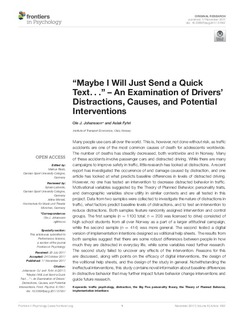| dc.description.abstract | Many people use cars all over the world. This is, however, not done without risk, as traffic accidents are one of the most common causes of death for adolescents worldwide. The number of deaths has steadily decreased, both worldwide and in Norway. Many of these accidents involve passenger cars and distracted driving. While there are many campaigns to improve safety in traffic, little research has looked at distractions. A recent report has investigated the occurrence of and damage caused by distraction, and one article has looked at what predicts baseline differences in levels of distracted driving. However, no one has tested an intervention to decrease distracted behavior in traffic. Motivational variables suggested by the Theory of Planned Behavior, personality traits, and demographic variables show utility in similar contexts and are all tested in this project. Data from two samples were collected to investigate the nature of distractions in traffic, what factors predict baseline levels of distractions, and to test an intervention to reduce distractions. Both samples feature randomly assigned intervention and control groups. The first sample (n = 1100 total; n = 208 was licensed to drive) consisted of high school students from all over Norway as a part of a larger attitudinal campaign, while the second sample (n = 414) was more general. The second tested a digital version of implementation intentions designed as volitional help sheets. The results from both samples suggest that there are some robust differences between people in how much they are distracted in everyday life, while some variables need further research. The second study failed to uncover any effects of the intervention. Reasons for this are discussed, along with points on the efficacy of digital interventions, the design of the volitional help sheets, and the design of the study in general. Notwithstanding the ineffectual interventions, this study contains novel information about baseline differences in distractive behavior that may further impact future behavior change interventions and guide future research. | nb_NO |

